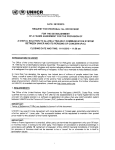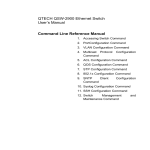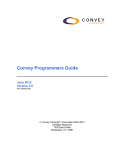Download A USER GUIDE FOR JARGON VERSION5 A. Hébert
Transcript
TECHNICAL REPORT
IGE–320
A USER GUIDE FOR JARGON VERSION5
A. H´
ebert
Institut de g´enie nucl´eaire
D´epartement de g´enie m´ecanique
´
Ecole
Polytechnique de Montr´eal
March 9, 2012
ii
IGE–320
Contents
Contents . . . . . . . . . . . . . . . . . . . . . . . . . . . . . . .
1
Introduction . . . . . . . . . . . . . . . . . . . . . . . . . .
2
Examples of BeanShell scripts . . . . . . . . . . . . . . . .
2.1
The IAEA-3D Diffusion Benchmark . . . . . . . . .
2.2
A Wigner-Seitz lattice cell with Macrolib . . . . . .
2.3
A Double-Heterogeneity lattice case with Macrolib .
2.4
A multi-parameter compo calculation with Microlib
2.5
The first UO2 Rowlands benchmark. . . . . . . . . .
2.6
Calling a parametrized CLE-2000 procedure . . . . .
2.7
Calling a CLE-2000 procedure with in-out CLE-2000
References . . . . . . . . . . . . . . . . . . . . . . . . . . . . . .
. . . . . .
. . . . . .
. . . . . .
. . . . . .
. . . . . .
. . . . . .
. . . . . .
. . . . . .
. . . . . .
variables
. . . . . .
.
.
.
.
.
.
.
.
.
.
.
.
.
.
.
.
.
.
.
.
.
.
.
.
.
.
.
.
.
.
.
.
.
.
.
.
.
.
.
.
.
.
.
.
.
.
.
.
.
.
.
.
.
.
.
.
.
.
.
.
.
.
.
.
.
.
.
.
.
.
.
.
.
.
.
.
.
.
.
.
.
.
.
.
.
.
.
.
.
.
.
.
.
.
.
.
.
.
.
.
.
.
.
.
.
.
.
.
.
.
.
.
.
.
.
.
.
.
.
.
.
ii
1
2
2
4
4
6
11
13
14
16
IGE–320
1
1 Introduction
The current version of Jargon uses calculation operators borrowed from DRAGON[1] and DONJON[2] .
The remote dispatching and asychroneous calculation capabilities of Jargon are described in Ref. 3. A
user guide for Jargon is available in Ref. 4.
Jargon Version5 is built on top of Ganlib Version5.[5] This version of Jargon is therefore 64-bit clean
and its ANSI-C and Fortran components are ISO-compliant.
Jargon can be executed in multiple ways. The simplest approach is to use BeanShell scripts[5] to
write complete data files. It is also possible to write a library of Computational schemes in Java or in
Cle-2000 and to call them from user-defined BeanShell scripts. Finally, we always have the possibility to
use graphical user interfaces (GUI) instead of BeanShell scripts[6] .
2
IGE–320
2 Examples of BeanShell scripts
The following examples are implemented as BeanShell scripts using classes from the Jargon framework.
Jargon contains two demo examples of Computational Schemes: SimpleCell and SimpleCompo. The
complete JavaDoc documentation is available in Ref. 4.
2.1
The IAEA-3D Diffusion Benchmark
import jargon.*;
myMacro = new Macrolib("myMacro", 2, 1, 1);
// mixture 1:
M1 = new Composition("M1", "medium");
myMacro.setDiff(M1, new float[] {1.5f, 0.4f});
myMacro.setTotal(M1, new float[] {3.0e-2f, 8.0e-2f});
myMacro.setNuSigf(M1, new float[] {0.0f, 0.135f});
myMacro.setChi(M1, new float[] {1.0f, 0.0f});
myMacro.setHFactor(M1, new float[] {0.0f, 0.135f});
myMacro.setScat(M1, 0, 1, new float[] {0.0f}, 1, 1);
myMacro.setScat(M1, 0, 2, new float[] {0.0f, 0.02f}, 2,
// mixture 2:
M2 = new Composition("M2", "medium");
myMacro.setDiff(M2, new float[] {1.5f, 0.4f});
myMacro.setTotal(M2, new float[] {3.0e-2f, 8.5e-2f});
myMacro.setNuSigf(M2, new float[] {0.0f, 0.135f});
myMacro.setChi(M2, new float[] {1.0f, 0.0f});
myMacro.setHFactor(M2, new float[] {0.0f, 0.135f});
myMacro.setScat(M2, 0, 1, new float[] {0.0f}, 1, 1);
myMacro.setScat(M2, 0, 2, new float[] {0.0f, 0.02f}, 2,
// mixture 3:
M3 = new Composition("M3", "medium");
myMacro.setDiff(M3, new float[] {1.5f, 0.4f});
myMacro.setTotal(M3, new float[] {3.0e-2f, 0.13f});
myMacro.setNuSigf(M3, new float[] {0.0f, 0.135f});
myMacro.setChi(M3, new float[] {1.0f, 0.0f});
myMacro.setHFactor(M3, new float[] {0.0f, 0.135f});
myMacro.setScat(M3, 0, 1, new float[] {0.0f}, 1, 1);
myMacro.setScat(M3, 0, 2, new float[] {0.0f, 0.02f}, 2,
// mixture 4:
M4 = new Composition("M4", "medium");
myMacro.setDiff(M4, new float[] {2.0f, 0.3f});
myMacro.setTotal(M4, new float[] {4.0e-2f, 1.0e-2f});
myMacro.setScat(M4, 0, 1, new float[] {0.0f}, 1, 1);
myMacro.setScat(M4, 0, 2, new float[] {0.0f, 0.04f}, 2,
// mixture 5:
M5 = new Composition("M5", "medium");
myMacro.setDiff(M5, new float[] {2.0f, 0.3f});
myMacro.setTotal(M5, new float[] {4.0e-2f, 5.5e-2f});
myMacro.setScat(M5, 0, 1, new float[] {0.0f}, 1, 1);
myMacro.setScat(M5, 0, 2, new float[] {0.0f, 0.04f}, 2,
2);
2);
2);
2);
2);
iaea3d = new Gigogne("iaea3d", "CAR3D", new int[]{9, 9, 4});
iaea3d.bc = new String[][] {{"X-","DIAG"},{"X+","VOID"},{"Y-","SYME"},
{"Y+","DIAG"},{"Z-","VOID"},{"Z+","VOID"},};
o = null;
iaea3d.media = new Composition[]{ M4, M4, M4, M4, M4, M4, M4, M4, M4,
M4, M4, M4, M4, M4, M4, M4, M4,
3
IGE–320
M4, M4, M4, M4,
M4, M4, M4,
M4, M4,
M4,
M4,
M4,
M4,
M4,
M4,
M4, M4,
M4, M4,
M4, o,
M4, o,
o, o,
o, o,
o,
M3, M2, M2, M2, M3, M2, M2, M1, M4,
M2, M2, M2, M2, M2, M2, M1, M4,
M2, M2, M2, M2, M1, M1, M4,
M2, M2, M2, M1, M4, M4,
M3, M1, M1, M4, o,
M1, M4, M4, o,
M4, o, o,
o, o,
o,
M3, M2, M2, M2, M3, M2, M2, M1, M4,
M2, M2, M2, M2, M2, M2, M1, M4,
M3, M2, M2, M2, M1, M1, M4,
M2, M2, M2, M1, M4, M4,
M3, M1, M1, M4, o,
M1, M4, M4, o,
M4, o, o,
o, o,
o,
M5, M4, M4, M4, M5, M4, M4, M4, M4,
M4, M4, M4, M4, M4, M4, M4, M4,
M5, M4, M4, M4, M4, M4, M4,
M4, M4, M4, M4, M4, M4,
M5, M4, M4, M4, o,
M4, M4, M4, o,
M4, o, o,
o, o,
o};
iaea3d.meshx = new float[]{0.0f, 20.0f, 40.0f, 60.0f, 80.0f, 100.0f,
120.0f, 140.0f, 160.0f, 180.0f};
iaea3d.meshz = new float[]{0.0f, 20.0f, 280.0f, 360.0f, 380.0f};
iaea3d.splitz = new int[] {1, 2, 1, 1};
iaea3d.text(myMacro);
myScheme = new SimpleCell("myScheme");
myScheme.setGigogne(iaea3d);
myScheme.setMacrolib(myMacro);
myScheme.setSolutionType("Trivac");
myScheme.setMaxr(500);
myScheme.setBase("DUAL", new int[]{3, 3});
myScheme.run();
source("assertS.bsh");
assertS(myScheme.operatorOut.lcmObj, "K-EFFECTIVE", 1, 1.028981f);
Script assertS.bsh is written:
assertS(lcmobj,key,ipos,refvalue) {
record=lcmobj.get(key);
myvalue=record[ipos-1];
if (Math.abs(myvalue - refvalue) > 1.0e-4 * Math.abs(refvalue)) {
System.out.println("============== error detected =================");
System.out.println("Reference=" + refvalue + " Calculated=" + myvalue);
IGE–320
throw new RuntimeException("exception in assertS");
} else {
System.out.println("Test successful");
}
}
2.2
A Wigner-Seitz lattice cell with Macrolib
import jargon.*;
myMacro = new Macrolib("myMacro", 1, 1, 1);
// mixture 1:
fuel = new Composition("fuel", "medium");
myMacro.setTotal(fuel, new float[] {0.36522f});
myMacro.setNuSigf(fuel, new float[] {0.05564f});
myMacro.setChi(fuel, new float[] {1.0f});
myMacro.setScat(fuel, 0, 1, new float[] {0.3234f}, 1, 1);
// mixture 2:
clad = new Composition("clad", "medium");
myMacro.setTotal(clad, new float[] {0.4029f});
myMacro.setScat(clad, 0, 1, new float[] {0.4000f}, 1, 1);
// mixture 3:
water = new Composition("water", "medium");
myMacro.setTotal(water, new float[] {0.3683f});
myMacro.setScat(water, 0, 1, new float[] {0.3661f}, 1, 1);
myGeom = new Gigogne("myGeom", "CARCEL", new int[]{2});
myGeom.bc = new String[][] {{"X-","REFL"},{"X+","REFL"},{"Y-","REFL"},
{"Y+","REFL"}};
myGeom.meshx = new float[] {0.0f, 3.6f};
myGeom.meshy = myGeom.meshx;
myGeom.radius = new float[] {0.0f, 0.829f, 1.029f};
myGeom.media = new Composition[] {fuel, clad, water};
myScheme = new SimpleCell("myScheme");
myScheme.setGigogne(myGeom);
myScheme.setMacrolib(myMacro);
myScheme.setOption("K");
myScheme.run();
source("assertS.bsh");
assertS(myScheme.operatorOut.lcmObj, "K-EFFECTIVE", 1, 1.0479352f);
2.3
A Double-Heterogeneity lattice case with Macrolib
import jargon.*;
myMacro = new Macrolib("myMacro", 1, 1, 1);
// mixture 1:
water = new Composition("water", "medium");
myMacro.setTotal(water, new float[] {0.3683f});
myMacro.setScat(water, 0, 1, new float[] {0.3661f}, 1, 1);
// mixture 2:
fuel = new Composition("fuel", "medium");
myMacro.setTotal(fuel, new float[] {0.36522f});
myMacro.setNuSigf(fuel, new float[] {0.05564f});
myMacro.setChi(fuel, new float[] {1.0f});
myMacro.setScat(fuel, 0, 1, new float[] {0.3234f}, 1, 1);
4
IGE–320
// mixture 3:
clad1 = new Composition("clad1", "medium");
myMacro.setTotal(clad1, new float[] {0.8453f});
myMacro.setScat(clad1, 0, 1, new float[] {0.5216f}, 1, 1);
// mixture 4:
clad2 = new Composition("clad", "medium");
myMacro.setTotal(clad2, new float[] {0.3683f});
myMacro.setScat(clad2, 0, 1, new float[] {0.0f}, 1, 1);
// double heterogeneity mixtures 5 and 6:
fuelGrain1 = new Composition("fuelgrain1", "medium");
fuelGrain2 = new Composition("fuelgrain2", "medium");
cote = 1.262082f;
lame = 1.322082f;
C1 = new Gigogne("C1", "CARCEL", new int[]{0});
C1.meshx = new float[]{0.0f, cote};
C1.meshy = C1.meshx;
C1.media = new Composition[]{clad2};
C2 = new Gigogne("C2", "CARCEL", new int[]{3});
C2.meshx = new float[]{0.0f, cote};
C2.meshy = C2.meshx;
C2.radius = new float[]{0.0f, 3.25296e-01f, 4.60039e-01f, 5.6343e-01f};
C2.media = new Composition[]{fuelGrain1, clad1, clad1, water};
C3 = new Gigogne("C3", "CARCEL", new int[]{1});
C3.meshx = new float[]{0.0f, cote};
C3.meshy = C3.meshx;
C3.radius = new float[]{0.0f, 4.1266e-01f};
C3.media = new Composition[]{fuelGrain2, water};
C4 = new Gigogne("C4", "CARCEL", new int[]{1});
C4.meshx = new float[]{0.0f, lame};
C4.meshy = new float[]{0.0f, cote};
C4.radius = new float[]{0.0f, 4.1266e-01f};
C4.media = new Composition[]{fuelGrain2, water};
C5 = new Gigogne("C5", "CARCEL", new int[]{1});
C5.meshx = new float[]{0.0f, lame};
C5.meshy = C5.meshx;
C5.radius = new float[]{0.0f, 5.76770008e-01f};
C5.media = new Composition[]{fuelGrain2, water};
assmbObj = new Gigogne("assmbObj", "CAR2D", new int[]{5,5});
assmbObj.bihet.setGeometry("SPHE");
assmbObj.bihet.setMixture(fuelGrain1, fuel, new float[]{0.4f, 0.0f},
new Composition[][]{{clad1, water, clad1}});
assmbObj.bihet.setMixture(fuelGrain2, fuel, new float[]{0.2f, 0.1f},
new Composition[][]{{water, fuel, water},{fuel, clad1, water}});
assmbObj.bihet.setRadius(new float[]{0.0f, 0.1f, 0.2f, 0.3f});
assmbObj.bihet.setRadius(new float[]{0.0f, 0.2f, 0.4f, 0.5f});
assmbObj.bc = new String[][] {{"X-","DIAG"},{"X+","REFL"},{"Y-","SYME"},
{"Y+","DIAG"}};
assmbObj.subgeo = new Gigogne[]{ C1, C3, C2, C3, C4,
C3, C3, C3, C4,
C2, C3, C4,
C3, C4,
C5 };
5
6
IGE–320
assmbObj.merge = new int[]{1,
2,
6,
3, 4,
7, 8,
10, 11,
12,
5,
9,
9,
9,
13 };
myScheme = new SimpleCell("myScheme");
myScheme.setGigogne(assmbObj);
myScheme.setMacrolib(myMacro);
myScheme.setType("ROT+");
myScheme.setCylinder("ASKE");
myScheme.setOption("B");
myScheme.setLeakType(new String[]{"B0","SIGS"});
myScheme.run();
source("assertS.bsh");
assertS(myScheme.operatorOut.lcmObj, "B2
2.4
B1HOM", 1, -1.970198e-02f);
A multi-parameter compo calculation with Microlib
import jargon.*;
myBurnupList = new float[]{9.375f, 18.75f, 37.5f, 75.0f, 500.0f};
myPower = 3.016e17f ; /* flux normalization factor in Mev/(s*cm) */
boronCont = 600.0e-6f ;
//
//---------------------------- new Isotope ----------------------------// Set the isotopes
U235 =new Isotope("U235", "U235", "U235_4", "APLIB2", "CEA93V4", "U235SS_4");
U238 =new Isotope("U238", "U238", "U238_4", "APLIB2", "CEA93V4", "U238SS_3");
O16 =new Isotope("O16", "O16", "O16_6", "APLIB2", "CEA93V4");
H2O =new Isotope("H2O", "H2O", "H2O_3_P5", "APLIB2", "CEA93V4");
AL27 =new Isotope("AL27", "AL27", "AL27_4", "APLIB2", "CEA93V4");
PU239=new Isotope("PU239", "PU239", "PU239_4", "APLIB2", "CEA93V4", "PU239SS_4");
PU240=new Isotope("PU240", "PU240", "PU240_4", "APLIB2", "CEA93V4", "PU240SS_4");
PU241=new Isotope("PU241", "PU241", "PU241_4", "APLIB2", "CEA93V4");
PU242=new Isotope("PU242", "PU242", "PU242_3", "APLIB2", "CEA93V4");
AM241=new Isotope("AM241", "AM241", "AM241_1", "APLIB2", "CEA93V4");
AM242M=new Isotope("AM242M", "AM242M", "AM242M_3", "APLIB2", "CEA93V4");
XE135PF=new Isotope("XE135PF", "XE135PF", "XE135PF_1", "APLIB2", "CEA93V4");
//
// Set self-shielding regions
U235.inrs = 1; U235.setIrset(0.0f, 38);
U238.inrs = 1; U238.setIrset(0.0f, 38);
PU239.inrs = 1; PU239.setIrset(0.0f, 38);
PU240.inrs = 1; PU240.setIrset(0.0f, 38);
//
// --------------------------------------------------------------------// definition of the depletion isotopic chain
chain_V4 = null;
try {
int c;
CharArrayWriter out = new CharArrayWriter();
File fin = new File("CompoShi.chain");
FileReader in = new FileReader(fin);
while ((c = in.read()) != -1) out.write(c);
chain_V4 = out.toString();
} catch(Exception e) {
System.out.println("============== error detected =================");
IGE–320
System.out.println(e);
return;
}
//
//---------------------------- COMPOSITION ----------------------------water = new Composition("water", "medium");
water.setComposition(new Isotope[]{H2O}, new float[]{2.3934e-02f});
water.temperature = 27.0f;
fuel1 = new Composition("fuel1", "medium");
fuel1.setComposition(new Isotope[]{U238, U235, O16, PU239, PU240},
new float[]{2.2089e-02f, 8.6623e-04f, 4.5910e-02f, 0.0f, 0.0f});
fuel1.temperature = 306.74f;
fuel2 = new Composition("fuel2", "medium");
fuel2.setComposition(new Isotope[]{U238, U235, O16, PU239, PU240},
new float[]{2.2089e-02f, 8.6623e-04f, 4.5910e-02f, 0.0f, 0.0f});
fuel2.temperature = 306.74f;
clad = new Composition("clad", "medium");
clad.setComposition(new Isotope[]{AL27}, new float[]{3.9222e-02f});
clad.temperature = 27.0f;
//
//------------------------------ MICROLIB -----------------------------myMicrolib = new Microlib("myMicrolib");
myMicrolib.ctra = "APOL"; // set type of transport correction
myMicrolib.chain = chain_V4;
myMicrolib.mixs = new Composition[]{water, fuel1, fuel2, clad};
myMicrolib.exec();
//---------------------------------------------------------------------//
//------------------------------- GIGOGNE -----------------------------cote = 1.262082f;
lame = 1.322082f;
C1 = new Gigogne("C1", "CARCEL", new int[]{2});
C1.meshx = new float[]{0.0f, cote};
C1.meshy = C1.meshx;
C1.radius = new float[]{0.0f, 3.0e-01f, 4.1266e-01f};
C1.media = new Composition[]{water, water, water};
C2 = new Gigogne("C2", "CARCEL", new int[]{3});
C2.meshx = new float[]{0.0f, cote};
C2.meshy = C2.meshx;
C2.radius = new float[]{0.0f, 3.25296e-01f, 4.60039e-01f, 5.6343e-01f};
C2.media = new Composition[]{clad, clad, clad, water};
C3 = new Gigogne("C3", "CARCEL", new int[]{2});
C3.meshx = new float[]{0.0f, cote};
C3.meshy = C3.meshx;
C3.radius = new float[]{0.0f, 3.0e-01f, 4.1266e-01f};
C3.media = new Composition[]{fuel1, fuel2, water};
C4 = new Gigogne("C4", "CARCEL", new int[]{2});
C4.meshx = new float[]{0.0f, lame};
C4.meshy = new float[]{0.0f, cote};
C4.radius = C3.radius;
C4.media = new Composition[]{fuel1, fuel2, water};
C5 = new Gigogne("C5", "CARCEL", new int[]{2});
C5.meshx = new float[]{0.0f, lame};
C5.meshy = C5.meshx;
7
IGE–320
C5.radius = C3.radius;
C5.media = new Composition[]{fuel1, fuel2, water};
myGeom = new Gigogne("myGeom", "CAR2D", new int[]{5,5});
myGeom.bc = new String[][] {{"X-","DIAG"},{"X+","REFL"},{"Y-","SYME"},
{"Y+","DIAG"}};
myGeom.subgeo = new Gigogne[]{ C1, C3, C2, C3, C4,
C3, C3, C3, C4,
C2, C3, C4,
C3, C4,
C5 };
myGeom.merge = new int[]{1, 2, 3, 2, 6,
2, 2, 4, 6,
5, 4, 6,
4, 6,
7 };
myGeom.text(myMicrolib);
myGeom.exec(myMicrolib);
//
// --------------------------------------------------------------------//
//--------------------------------- SYBIL -----------------------------// Tracking of the geometry for Eurydice-2
myTrack = new Sybil("myTrack");
myTrack.edit = 1;
myTrack.title = "CompoShi tracking with Sybil";
myTrack.maxr = 40;
myTrack.exec(myGeom);
//---------------------------------------------------------------------//
//------------------------------- Autop -------------------------------Autop myShi = new Autop("myShi", "Shiba");
/*myShi.setSimpleSS("W1", U238, new Composition[]{fuel1});
myShi.setSimpleSS("W2", U238, new Composition[]{fuel2});
myShi.setSimpleSS("W1", U235);
myShi.setSimpleSS("W1", PU239);
myShi.setSimpleSS("W1", PU240);*/
myShi.exec(myMicrolib, myTrack);
//---------------------------------------------------------------------//
//-------------------------------- COMPO ------------------------------// Initialize the compo object
myCompo = new Compo("myCompo");
myCompo.setGlobal("BCON", "VALU", "REAL");
myCompo.setGlobal("FTMP", "TEMP", myShi, fuel1);
myCompo.setGlobal("WTMP", "TEMP", myShi, water);
myCompo.setGlobal("BURN", "IRRA");
myCompo.setGlobal("FLUB", "FLUB");
myCompo.setGlobal("PUIS", "POWR");
myCompo.setGlobal("XE1", "CONC", XE135PF, myShi, fuel1);
myCompo.setGlobal("XE2", "CONC", XE135PF, myShi, fuel2);
myCompo.setLocal("burn", "IRRA");
myCompo.setLocal("flub", "FLUB");
myCompo.setLocal("mass", "MASL");
myCompo.setLocal("xe", "CONC", XE135PF);
myCompo.setLocal("mtmp", "TEMP");
myCompo.comment = "’First line of comment’\n’Second line of comment’\n";
myCompo.exec();
8
IGE–320
//---------------------------------------------------------------------//
//-------------------------------- ASM --------------------------------myAsm = new Asm("myAsm", "PIJ");
myAsm.ecco = true;
myAsm.exec(myShi, myTrack);
//---------------------------------------------------------------------//
//-------------------------------- FLUX -------------------------------myFlux = new Flux("myFlux", "B");
myFlux.leak = new String[]{"B1", "ECCO"};
myFlux.exec(myAsm, myShi, myTrack);
System.out.println("The value of K-EFFECTIVE is " + myFlux.getKeff());
//-----------------------------------------------------------------------//
// Compute the normalization factor
//
myVolume = ((cote*7.0f)+(lame*2.0f))*((cote*7.0f)+(lame*2.0f));
normFct1 = (myPower * 1.60207e-13f) / myVolume;
normFct2 = normFct1 / (2.651005f * 1.00115f);
System.out.println("volume_assemblage= " + this.myVolume + " cm**3. in-fuel power= "
+ normFct2 + " MW/tonne");
System.out.println("normalization power= " + normFct1 + " W/CC");
//
// Burnup loop #####################################################
//
evobeg = 0.0f;
//--------------------------------- EVO ---------------------------------myEvo = new Evo("myEvo");
myEvo.solution = "RUNG";
myEvo.eps2 = 100.0f;
// ----------------------------------------------------------------------for (istep=0; istep<myBurnupList.length; istep++) {
evoend = myBurnupList[istep] / normFct2;
System.out.println("Burnup step " + (istep+1) + " between " + evobeg + " and "
+ evoend + " day:");
if (istep == 0) {
// execution of the burnup operator (first step)
myEvo.edit = 2;
myEvo.expm = 1.0f;
myEvo.satureInit = true;
myEvo.setDepl(evobeg, evoend, "DAY", "W/CC", normFct1);
myEvo.exec(myShi, myFlux, myTrack);
} else {
// execution of the burnup operator (subsequent steps)
myEvo.edit = 1;
myEvo.expm = 1.0e15f;
myEvo.satureInit = false;
myEvo.extr = true;
myEvo.setDepl(evobeg, evoend, "DAY", "W/CC", normFct1);
myEvo.exec(myEvo, myShi, myFlux, myTrack);
}
System.out.println("Nominal flux at step " + (istep+1) + " and at " + evoend + " DAY:");
//
// Self-Shielding calculation
System.out.println("self-shielding at " + evoend + " DAY:");
//-------------------------------- Autop --------------------------------myShi.passes = 1;
9
10
IGE–320
myShi.exec(myShi, myMicrolib, myTrack);
//-----------------------------------------------------------------------//
//--------------------------------- ASM ---------------------------------myAsm = new Asm("myAsm", "PIJ");
myAsm.ecco = true;
myAsm.exec(myShi, myTrack);
//-----------------------------------------------------------------------//
//--------------------------------- FLUX --------------------------------myFlux.exec(myFlux, myAsm, myShi, myTrack);
System.out.println("The value of K-EFFECTIVE is " + myFlux.getKeff());
//-----------------------------------------------------------------------float step2 = myBurnupList[istep];
//
//------------------------------- EDITION --------------------------------Edition myEdit = new Edition("myEdit");
myEdit.options = new String[]{"P0W"};
myEdit.cond = new int[]{74, 99};
myEdit.merge = "CELL";
myEdit.micr2 = new Isotope[]{U235,U238,PU239,PU240,PU241,PU242,
AM241,AM242M,XE135PF};
myEdit.save = "EDITCDAT
1";
myEdit.sph = new Bivac("Sph_obj", "DUAL", new int[]{2,2});
myEdit.exec(myFlux, myShi, myTrack, myGeom);
//------------------------------------------------------------------------//
// Normalization to the reactor power
myEvo.edit = 2;
myEvo.unsetDepl();
myEvo.setSave(evoend, "DAY", "W/CC", normFct1);
myEvo.exec(myEvo, myShi, myFlux, myTrack);
//
//--------------------------------- COMPO --------------------------------// Compo object construction
myCompo.edit = 3;
myCompo.setSet(evoend, "DAY");
myCompo.setParam("BCON", boronCont);
myCompo.exec(myCompo, myEdit, myEvo, myShi);
//------------------------------------------------------------------------evobeg = evoend;
}
//
// Export the compo
myCompo.lcmObj.expor();
System.out.println("CompoShi testcase completed");
Note that the depletion chain in file CompoShi.chain is defined as
DEPL LIB: APLIB2 FIL: CEA93V4 CHAIN
U234
FROM N2N
1.0000E+00 U235
U235
FROM NG
1.0000E+00 U234
U236
FROM NG
1.0000E+00 U235
U238
NP237
FROM NG
1.0000E+00 U236
PU238
FROM NG
1.0000E+00 NP237
PU239
FROM NG
1.0000E+00 PU238
DECAY
1.0000E+00 CM243
PU240
FROM NG
1.0000E+00 PU239
DECAY
1.0000E+00 CM242
NG
DECAY
1.0000E+00 U238
1.0000E+00 CM244
11
IGE–320
PU241
PU242
AM241
AM242M
AM243
CM242
CM243
CM244
FROM
FROM
FROM
FROM
FROM
FROM
FROM
FROM
NG
NG
DECAY
NG
NG
NG
NG
NG
1.0000E+00
1.0000E+00
1.0000E+00
1.1500E-01
1.0000E+00
7.4340E-01
1.0000E+00
1.0000E+00
PU240
PU241
PU241
AM241
PU242
AM241
CM242
CM243
I135PF
XE135PF FROM DECAY
1.0000E+00 I135PF
ND143PF
ND144PF FROM NG
1.0000E+00 ND143PF
ND145PF FROM NG
1.0000E+00 ND144PF
ND146PF FROM NG
1.0000E+00 ND145PF
ND147PF FROM NG
1.0000E+00 ND146PF
ND148PF FROM NG
1.0000E+00 ND147PF
PM147PF FROM DECAY
1.0000E+00 ND147PF
PM148PF FROM NG
5.3000E-01 PM147PF
PM148MPF FROM NG
4.7000E-01 PM147PF
PM149PF FROM NG
1.0000E+00 PM148PF
SM149PF FROM DECAY
1.0000E+00 PM149PF
SM150PF FROM NG
1.0000E+00 SM149PF
SM151PF FROM NG
1.0000E+00 SM150PF
SM152PF FROM NG
1.0000E+00 SM151PF
EU153PF FROM NG
1.0000E+00 SM152PF
EU154PF FROM NG
1.0000E+00 EU153PF
EU155PF FROM NG
1.0000E+00 EU154PF
MO95PF TC99PF RH103PF RH105PF
AG109PF XE131PF CS133PF
PSU5U PSU8U PSP9U PSP0U PSP1U PSP2U
ENDCHAIN
2.5
NG
1.4160E-01 AM241
NG
1.0000E+00 AM243
NG
1.0000E+00 PM148MPF
The first UO2 Rowlands benchmark.
This data file corresponds to the first UO2 Rowlands benchmark solved with the following options:
• Both self-shielding and flux calculations are performed using the long characteristics method of Igor
Suslov.[7, 8]
• Distributed self-shielding effects are taken into account only for 238 U, using six layers in the fuel
pin. The Ribon extended method[9] is used for 235 U and 238 U and a classical subgroup approach
(similar to the Helios or Wims-7 approach) is used for Zirconium.
• Cross section data is recovered from an isotopic multigroup library in Draglib format.
// UO2 Rowlands benchmark 1 with MCCG
import jargon.*;
//
//---------------------------- new Isotope ----------------------------// Set the isotopes
U235 = new Isotope("U235", "U235", "U235", "DRAGON", "DLIB_J2");
U238 = new Isotope("U238", "U238", "U238", "DRAGON", "DLIB_J2");
O16 = new Isotope("O16", "O16", "O16", "DRAGON", "DLIB_J2");
H1
= new Isotope("H1", "H1", "H1_H2O", "DRAGON", "DLIB_J2");
ZR
= new Isotope("ZR", "ZR", "Zr0", "DRAGON", "DLIB_J2");
//
// Set non-depleting isotopes and self-shielding regions
IGE–320
O16.noev = true;
H1.noev = true;
U235.inrs = 1; U235.setRibox(1);
U238.inrs = 1; U238.setRibox(1);
ZR.inrs = 2;
ZR.setRibox();
ZR.noev = true;
//
//---------------------------- COMPOSITION ----------------------------fuel1 = new Composition("fuel1", "medium");
fuel1.setComposition(new Isotope[]{U238, U235, O16},
new float[]{2.2604e-02f, 7.0803e-04f, 4.6624e-02f});
fuel1.temperature = 19.84f;
fuel2 = fuel1.clone("fuel2");
fuel3 = fuel1.clone("fuel3");
fuel4 = fuel1.clone("fuel4");
fuel5 = fuel1.clone("fuel5");
fuel6 = fuel1.clone("fuel6");
clad = new Composition("clad", "medium");
clad.setComposition(new Isotope[]{ZR}, new float[]{4.3241e-02f});
clad.temperature = 19.84f;
water1 = new Composition("water1", "medium");
water1.setComposition(new Isotope[]{H1, O16}, new float[]{6.6988e-2f,
3.3494e-2f});
water1.temperature = 19.84f;
water2 = new Composition("water2", "medium");
water2.setComposition(new Isotope[]{H1, O16}, new float[]{6.6988e-2f,
3.3494e-2f});
water2.temperature = 19.84f;
//
//------------------------------ MICROLIB -----------------------------myMicrolib = new Microlib("myMicrolib", "PTSL");
myMicrolib.ctra = "APOL"; // set type of transport correction
myMicrolib.mixs = new Composition[]{fuel1, fuel2, fuel3, fuel4, fuel5,
fuel6, clad, water1, water2};
myMicrolib.edit = 5;
myMicrolib.text();
myMicrolib.exec();
//---------------------------------------------------------------------cell = new Gigogne("cell", "CARCEL", new int[]{8});
cell.radius = new float[]{0.0f, 0.2529822f, 0.334664f, 0.3577709f,
0.3794733f, 0.3898718f, 0.40f, 0.45f, 0.5748331f };
cell.meshx = new float[]{0.0f, 1.2f};
cell.meshy = cell.meshx;
cell.media = new Composition[]{fuel1, fuel2, fuel3, fuel4, fuel5, fuel6,
clad, water1, water2};
cell.bc = new String[][] {{"X-","REFL"},{"X+","REFL"},{"Y-","REFL"},
{"Y+","REFL"},};
cell.text(myMicrolib);
cell.exec(myMicrolib);
Mccg myTrack = new Mccg("myTrack");
myTrack.edit = 1;
myTrack.title = "UO2 Rowlands benchmark 1 with MCCG";
myTrack.maxr = 40;
myTrack.trak = "TISO";
myTrack.nangl = 12;
myTrack.dens = 12.0f;
myTrack.symm = -1; // remove automatic symmetry detection
12
IGE–320
13
myTrack.moc = "CACB";
myTrack.innerMax = 100;
myTrack.innerEps = 1.0e-5f;
myTrack.krylov = 10;
myTrack.exec(cell);
Autop myShi = new Autop("myShi", "Ribox");
myShi.solution = "ARM";
myShi.setSimpleSS("W1", U238, new Composition[]{fuel1});
myShi.setSimpleSS("W2", U238, new Composition[]{fuel2});
myShi.setSimpleSS("W3", U238, new Composition[]{fuel3});
myShi.setSimpleSS("W4", U238, new Composition[]{fuel4});
myShi.setSimpleSS("W5", U238, new Composition[]{fuel5});
myShi.setSimpleSS("W6", U238, new Composition[]{fuel6});
myShi.setSimpleSS("W1", U235);
myShi.setSimpleSS("W1", ZR);
myShi.text(myMicrolib);
myShi.exec(myMicrolib, myTrack);
myAsm = new Asm("myAsm", "ARM");
myAsm.text();
myAsm.exec(myShi, myTrack);
myFlux = new Flux("myFlux", "K");
myFlux.leak = new String[]{"B0", "SIGS"};
myFlux.exec(myAsm, myShi, myTrack);
System.out.println("The value of K-EFFECTIVE is " + myFlux.getKeff());
source("assertS.bsh");
assertS(myFlux.lcmObj, "K-EFFECTIVE", 1, 1.3924694f);
2.6
Calling a parametrized CLE-2000 procedure
In cases where an application software is called from a multi-physics application, it is likely that
the multi-physics application will need to call parametrized CLE-2000 procedures (with “.c2m” suffix).
This approach provides an efficient way of communication between the application software and the
multi-physics application. It also permit to develop computational schemes outside the scope (i.e., independently) of the multi-physics application. Parameters are either LCM objects (memory-resident) or
files that are managed by the operating system. Multi-physics applications can be programmed in Java
using the Jargon framework.
In the following example, a parametrized procedure, TESTproc.c2m, take two object parameters and
three CLE-2000 input variables. Note that the CLE-2000 variables are always defined after LCM and file
objects. The first parameter, MACRO ASCII, is an ascii file written by the procedure and containing an
export of the information pointed by the second parameter MACRO. This second parameter is a memory
resident LCM object containing a Macrolib. It is accessed in read-only mode. The procedure also prints
a table-of-content of the root directory of MACRO, using the UTL: module of the GANLIB. The procedure
TESTproc.c2m is implemented as
REAL KEFF1 KEFF2 ;
INTEGER I123 ;
PARAMETER MACRO_ASCII MACRO ::
EDIT 1
::: SEQ_ASCII MACRO_ASCII ;
::: LINKED_LIST MACRO ;
;
:: >>KEFF1<< >>KEFF2<< >>I123<< ;
MODULE UTL: END: ;
*
IGE–320
14
UTL: MACRO :: DIR ;
MACRO_ASCII := MACRO ;
ECHO "KEFF1=" KEFF1 ""KEFF2=" KEFF2 "I123=" I123 ;
ECHO "procedure TESTproc completed" ;
END: ;
QUIT "XREF" .
More information about the development of CLE-2000 procedures can be found in Ref. 10.
The next Beanshell script is an example of how a multi-physics application can call such a procedure.
A LCM object containing a Macrolib is first created by importing its information from an existing ascii
file named MACRO1. Next, a call to method my cle2000.exec() is performed to execute TESTproc.c2m.
This example is implemented in ANSI-C in Ref. 5. The corresponding Beanshell script is written
import jargon.*;
System.out.println("Beginning of test");
// create the LCM object containing a Macrolib
my_lcm = new Jlcm("LCM_IMP", "MACRO1");
my_lcm.lib();
// construct the lifo stack
my_lifo = new Lifo();
my_lifo.push("MACRO_ASCII1", File.class, "ASCII", "my_ascii_file");
my_lifo.push("MACRO1", my_lcm);
my_lifo.push("value1", 1.703945f);
my_lifo.push("value2", 1.562276f);
my_lifo.push("value3", 12345);
my_lifo.lib();
// call the parametrized procedure
my_cle2000 = new Cle2000("TESTproc", my_lifo);
my_cle2000.exec();
// erase the lifo stack
while (my_lifo.getMax() > 0) {
my_node = my_lifo.pop();
System.out.println("---->" + my_node);
}
System.out.println("successful end of execution");
2.7
Calling a CLE-2000 procedure with in-out CLE-2000 variables
The CLE-2000 API also offers the possibility to exchange CLE-2000 variables with a procedure. The
following CLE-2000 procedure permits to compute the factorial of a number, as proposed in Ref. 10.
Here, n and n fact are input and output CLE-2000 variable, respectively. The fact.c2m procedure is
written
!
! Example of a recursive procedure.
!
! input to "fact": *n*
! output from "fact": *n_fact*
!
INTEGER
n n_fact prev_fact ;
:: >>n<< ;
IF n 1 = THEN
EVALUATE n_fact := 1 ;
ELSE
IGE–320
15
EVALUATE n := n 1 - ;
! Here, "fact" calls itself
PROCEDURE fact ;
fact ::
<<n>> >>prev_fact<< ;
EVALUATE n_fact := n 1 + prev_fact * ;
ENDIF ;
:: <<n_fact>> ;
QUIT " Recursive procedure *fact* XREF " .
This example is implemented in ANSI-C in Ref. 5. The same procedure fact.c2m can be called from
a Beanshell script, using
import jargon.*;
System.out.println("Beginning of test");
// construct the lifo stack
my_lifo = new Lifo();
my_lifo.push("input_val", 5);
my_lifo.push("output_val", Integer.class);
my_lifo.lib();
// call the parametrized procedure
my_cle2000 = new Cle2000("fact", my_lifo);
my_cle2000.exec();
// erase the lifo stack
while (my_lifo.getMax() > 0) {
my_node = my_lifo.pop();
System.out.println("---->" + my_node);
}
System.out.println("successful end of execution");
16
IGE–320
References
[1] 1. G. Marleau, A. H´ebert and R. Roy, “New Computational Methods Used in the Lattice Code
Dragon,” Proc. Int. Top. Mtg. on Advances in Reactor Physics, Charleston, USA, March 8–11, 1992.
´
[2] D. Sekki, A. H´ebert and R. Chambon, “A User’s Guide for DONJON Version 4,” IGE-300, Ecole
Polytechnique de Montr´eal, Institut de G´enie Nucl´eaire, 2009.
[3] A. H´ebert, “Coarse-Grain Parallelism Using Remote Method Invocation”, Proc. Int. Conf. on Supercomputing in Nuclear Applications, Paris, France, September 22–24, 2003.
[4] See http://www.polymtl.ca/jargon.
´
[5] A. H´ebert and R. Roy, “The Ganlib Version5 Developer’s Guide,” IGE-313, Ecole
Polytechnique de
Montr´eal, Institut de G´enie Nucl´eaire, 2009.
[6] P. Niemeyer and J. Knudsen, “Learning Java,” O’Reilly & Associates, 2002. See also
http://www.beanshell.org/.
[7] I. R. Suslov, “Solution of Transport Equation in 2– and 3–Dimensional Irregular Geometry by the
Method of Characteristics”, Joint Int. Conf. on Mathematical Methods and Supercomputing in
Nuclear Applications, Karlsruhe, Germany, April 19–23, 1993.
[8] I. R. Suslov, “An Algebraic Collapsing Acceleration Method for Acceleration of the Inner (Scattering)
Iterations in Long Characteristics Transport Theory”, Int. Conf. on Supercomputing in Nuclear
Applications, Paris, France, September 22–24, 2003.
[9] A. H´ebert, “Development of a New Resonance Self-Shielding Methodology Based on Probability
Table Information”, Int Mtg. on Nuclear Mathematical and Computational Sciences, April 6–10,
Gatlinburg, Tennessee, 2003.
´
[10] R. Roy, The CLE-2000 Tool-Box, Report IGE–163, Institut de g´enie nucl´eaire, Ecole
Polytechnique
de Montr´eal, Montr´eal, Qu´ebec (1999).
























